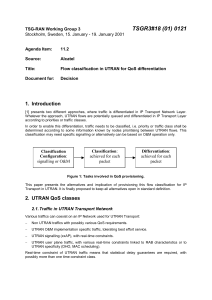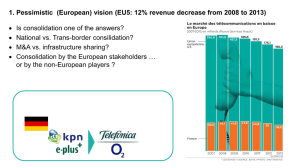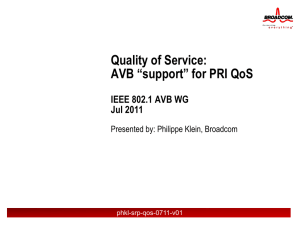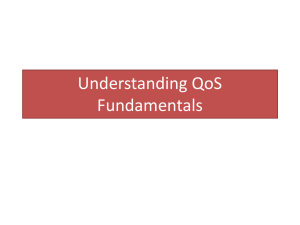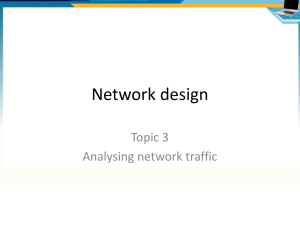R3-010191 QoS in IP UTRAN
advertisement
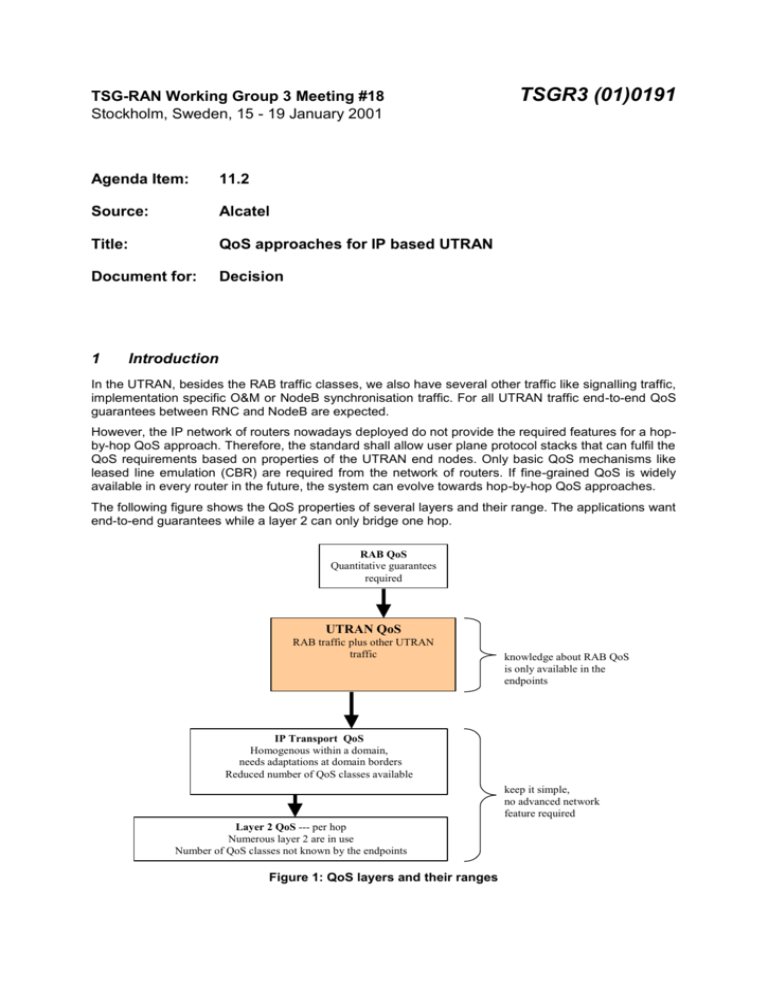
TSG-RAN Working Group 3 Meeting #18 Stockholm, Sweden, 15 - 19 January 2001 Agenda Item: 11.2 Source: Alcatel Title: QoS approaches for IP based UTRAN Document for: Decision 1 TSGR3 (01)0191 Introduction In the UTRAN, besides the RAB traffic classes, we also have several other traffic like signalling traffic, implementation specific O&M or NodeB synchronisation traffic. For all UTRAN traffic end-to-end QoS guarantees between RNC and NodeB are expected. However, the IP network of routers nowadays deployed do not provide the required features for a hopby-hop QoS approach. Therefore, the standard shall allow user plane protocol stacks that can fulfil the QoS requirements based on properties of the UTRAN end nodes. Only basic QoS mechanisms like leased line emulation (CBR) are required from the network of routers. If fine-grained QoS is widely available in every router in the future, the system can evolve towards hop-by-hop QoS approaches. The following figure shows the QoS properties of several layers and their range. The applications want end-to-end guarantees while a layer 2 can only bridge one hop. RAB QoS Quantitative guarantees required UTRAN QoS RAB traffic plus other UTRAN traffic knowledge about RAB QoS is only available in the endpoints IP Transport QoS Homogenous within a domain, needs adaptations at domain borders Reduced number of QoS classes available keep it simple, no advanced network feature required Layer 2 QoS --- per hop Numerous layer 2 are in use Number of QoS classes not known by the endpoints Figure 1: QoS layers and their ranges 2 QoS in IP networks The aim of this paper is not to promote Diffserv versus Intserv, since both can be applied. It shall give some QoS background for the selection of the user plane protocols in UTRAN. To recall the properties of the QoS mechanisms a brief description is given here. Intserv gives quantitative QoS guarantees, but needs per-flow state information in intermediate routers. To set-up the reservations from end-to-end, signalling protocols like RSVP are available. This approach does not scale well in the network. Diffserv aggregates flows with similar QoS requirements together, so there is no need for per-flow states in the core routers. The ingress edge routers handle the per-flow tasks e.g. policing misbehaving flows. Therefore this approach scales well. QoS is treated as a per-hop-property, so the network nodes and their per-hop behaviour must be carefully set-up to give end-to-end QoS guarantees to individual flows. Intserv and Diffserv do not exclude each other, e.g. Intserv over a Diffserv network is possible (RFC 2998). The following figure shows an example network. It is assumed that the three network domains are operated by different providers, using their own type of network (e.g. Intserv-based, Diffserv,...). For the UTRAN nodes, the Edge Routers are the only visible nodes to negotiate about their QoS needs. The applications just want to have an end-to-end QoS guarantee (UTRAN QOS), but how the networks fulfil the QoS guarantees should be hidden. Last mile domain RNC ISP1 domain ISP2 domain Edge Router Edge Router IP Network of routers ER RNC Last mile domain Edge Router ER IP Network of routers Edge Router Node B Node B Node B Node B Figure 2: network example 3 UTRAN Hop-by-Hop QoS Approach This approach relies on the QoS differentiation, which is provided by the IP backbone. This means the UTRAN internal flows (e.g. RAB traffic, NBAP signalling, ...) have to be mapped to the IP network. This mapping is not obvious because of the specific properties of UTRAN traffic. Due to the fact that the RLC/MAC layer are on RNC side, even the best effort RAB QoS class becomes time constraint traffic in UTRAN, but with more relaxed delay requirements than the conversational RAB QoS class. The delay requirements themselves are dependent from the MAC strategy in the RNC, which is manufacturer dependent. QoS differentiation in the IP backbone could be provided by Diffserv for example. Scheduler algorithms and strategies from the installed routers are used and must be configured to meet the UTRAN requirements. The last mile between the edge router and a NodeB is assumed to be a bottleneck for all UTRAN traffic flows. The adaptation to the low speed link has to be done by L2 techniques. Advanced functions like QoS differentiation, segmentation and multiplexing are needed in L2. For example, the PPP protocol is a meaningful candidate for this adaptation. It provides with its extensions Multi-Class PPP and PPPmux the required QoS differentiation, segmentation and multiplexing functionality. However, still some issues need to be solved: A mechanism shall be defined to inform the edge router about the needed quality classes towards the NodeB and the parameters used for the differentiation. It shall be defined on which edge router functionality the standard design relies on, and what can remain implementation dependent. The interworking of PPPmux with MC-PPP should be defined, for instance the availability of a separate PPPmux instance per QoS class shall be clarified. 4 UTRAN End-to-End QoS Approach The end-to-end approach provides QoS differentiation for the UTRAN traffic flows inside the UTRAN NEs. User plane protocol proposals like CIP and LIPE rely on this principle. But also the PPPmux based proposal can provide an e2e approach by tunnelling the PPP protocol via L2TP (TCRTP). The queuing and scheduling is performed inside the NEs under control of the UTRAN equipment manufacturer. In the IP backbone only one QoS class is needed for UTRAN traffic, which could be the expedited forwarding (EF) class of Diffserv. The QoS differentiation is simpler because the quality classes are well known inside the NEs and the complex management function to distribute the QoS parameter in the IP network can be avoided. However, for the implementation dependent O&M traffic the head of line blocking problem still exists. In case the edge router provides on data link layer only one QoS class, IP fragmentation at the O&M center could be configured to a reasonable IP packet size. If the edge router provides at least two QoS classes (ML-PPP) the best effort O&M traffic could easily be distinguished from the tunnel carrying the other UTRAN traffic. 5 Conclusion The hop-by-hop approach may provide better network efficiency in the backbone by requiring more advanced functionality from the IP backbone equipment. Some of the protocols for this approach are in early draft status in IETF. Therefore, it may take a long time before this functionality will be widely available in the installed network base. The end-to-end approach is less demanding from the IP network side. The critical QoS relevant features are part of the UTRAN NEs. This allows operators to introduce IP transport by using legacy IP networks without the need for a complete IP network upgrade. The usage of tunnels for the end-to-end approach does not exclude the hop-by-hop solution. The UTRAN NE implementations can be configured to run without tunnels and mark the QoS differentiation towards the edge router. 6 Proposal It is proposed to add chapter 3 and chapter 4 of this document to the study area of the Technical Report in the QoS section. It is proposed to add the following text to the agreement section in chapter '7.2 QoS differentiation' of the Technical Report. The user plane protocol stack standardised for IP transport shall allow the following two options for the QoS differentiation of UTRAN traffic classes. QoS differentiation provided by the IP network on a hop-by-hop basis, and QoS differentiation provided by the UTRAN NEs on an end-to-end basis.


